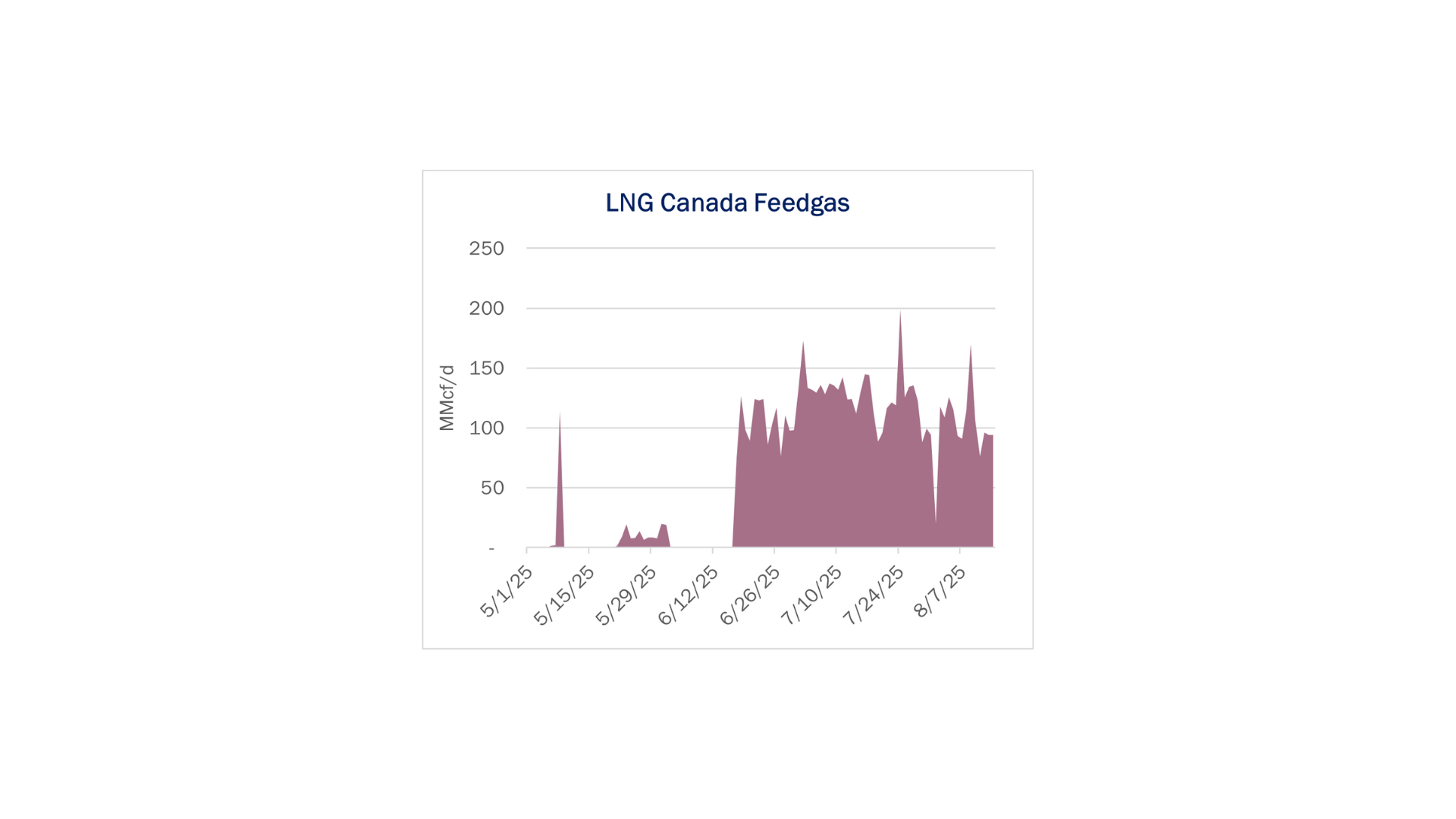Executive Summary:
Infrastructure: LNG Canada continues to conduct commissioning and has requested to export more LNG.
Rigs: Total US rigs remained steady W-o-W at 532 for the week of Aug. 9.
Flows: US natural gas volumes averaged 70.4 Bcf/d in pipeline samples for the week ending August 17, up 0.1% W-o-W.
Storage: Traders expect the EIA to report a 22 Bcf injection for the week ending Aug. 15.
Infrastructure:
Commissioning work continues at LNG Canada, albeit with some apparent setbacks. Canada’s first LNG export project seeks to export more volume from the recently started facility near Kitimat, British Columbia.
LNG Canada is requesting to amend its annual export volumes authorization. Currently permitted to export ~38 Bcm of natural gas annually (~3.7 Bcf/d), the project on Aug. 6 applied to the Canada Energy Regulator (CER) to increase capacity by 6.4% to ~40.5 Bcm (~3.9 Bcf/d). LNG Canada cites a technical study performed in 2021 that found the production capacity of each train could be up to ~6.4% greater than previously estimated.
The LNG Canada consortium includes Shell (SEL), Petronas, PetroChina and Mitsubishi. The partners are currently constructing Trains 1 and 2 as part of Phase 1 at the facility. Phase 2, if it reaches a final investment decision, would see two more identical trains built. CER’s export authorization covers the liquefaction capacity of both phases.
While annual capacity would increase if authorized, the request doesn’t seek to increase the total export capacity over the life of the project. The consortium had originally expected that Phase 2 would “follow closely on the heels of completion of Trains 1 and 2”. But now the earliest Phase 2 would begin service is in the early 2030s, or 6-7 years after Phase 1, LNG Canada said. The delay means total production over the life of the facility would not need to increase to accommodate the increase in annual LNG production.
Train 1 at LNG Canada is currently undergoing commissioning and appears to have experienced some setbacks. Commissioning began in June, and deliveries to the facility on TC Energy’s (TRP) Coastal GasLink pipeline have averaged 115 MMcf/d since then with no real ramp in feedgas (see figure). At full capacity, Phase 1 is expected to receive 1.8-1.9 Bcf/d, with feedgas for Train 1 around 930 MMcf/d once fully in service.
LNG Canada sent notices to the local community in May warning of increased flaring until July 31 as Train 1 underwent commissioning and planned startup, but a notice published Monday (Aug. 11) advised that flaring associated with the restart of Train 1 would occur through Aug. 13.
The lower feedgas to the facility may reflect issues during commissioning that have prevented Train 1 from ramping. LNG Canada reported that its first export cargo departed the facility on June 30, 13 days after beginning commissioning. Meanwhile, LNG Canada expects Train 2 “to be brought into operation within approximately 6 months”, but if significant issues with Train 1 commissioning persist, there is added risk to this timeline and could see Train 2’s in-service delayed.
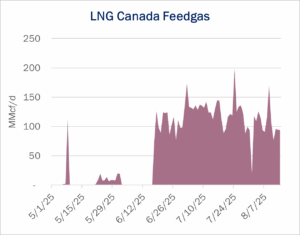
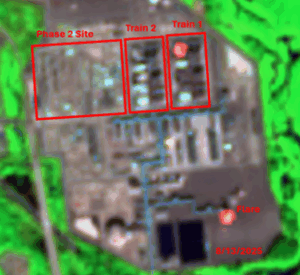
Rigs:
Total US rigs remained steady W-o-W at 532 for the week of Aug. 9. The Anadarko (+3), Eagle Ford (+1), Powder River (+1) and Uinta (+1) gained rigs while the Permian (-1), Marcellus+Utica (-1) and Bakken (-1) lost rigs W-o-W. The WCSB lost 4 rigs.
At the company level, ET gained 6 rigs while TRGP (-4), EPD (-5), KMI (-2) and KNTK (-2) lost rigs on their G&P systems. Notable system changes include a 3 rig increase on TRGP–Delaware, a drop of 2 rigs on EPD–Delaware, a 3 rig drop on EPD–Navitas, and a 3 rig drop on Altagas W-o-W.
See East Daley Analytics’ weekly Rig Activity Tracker for more information on rigs by basin and company.
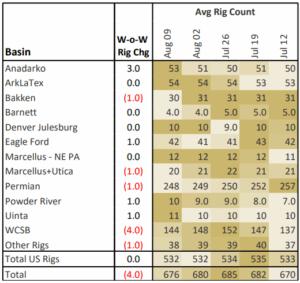
Flows:
US natural gas volumes averaged 70.4 Bcf/d in 1pipeline samples for the week ending August 17, up 0.1% W-o-W.
Gas basin samples increased 0.4% W-o-W to 44.1 Bcf/d. The Haynesville sample increased 0.4% to 10.7 Bcf/d, and the Marcellus+Utica rose 0.3% to 32.4 Bcf/d.
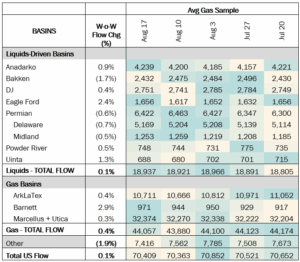
Storage:
Traders and analysts expect the Energy Information Administration (EIA) to report a 22 Bcf net injection for the week ending Aug. 15. A 22 Bcf injection would decrease the surplus to the five-year average by 13 Bcf to 183 Bcf. The storage deficit to last year would increase 7 Bcf to 86 Bcf.
In the new monthly Macro Supply & Demand Report, East Daley now expects inventories to land at 3,921 Bcf at the end of the injection season, or 203 Bcf above the five-year average. This will keep a lid on prices for the meantime as we expect Henry Hub to average around $3.20/MMBtu through September and October. With 11 weeks left in the injection season, capacity holders must inject just under 65 Bcf/week to hit our target. The five-year average injection pace for the next 11 weeks is 63 Bcf, so our target assumes that slightly more gas will be injected each week as has been the case over much of the summer.
See the latest Macro Supply & Demand Report for more analysis on the storage outlook.
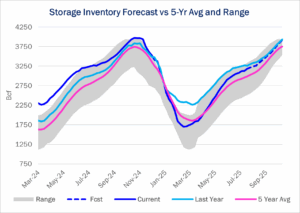
Calendar:

Subscribe to East Daley’s The Daley Note (TDN) for midstream insights delivered daily to your inbox. The Daley Note covers news, commodity prices, security prices, and EDA research likely to affect markets in the short term.


